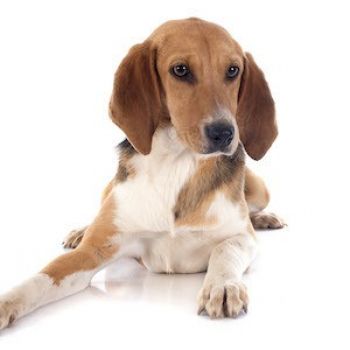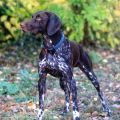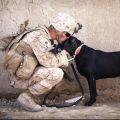The Beagle Harrier is a unique and captivating breed that combines the best qualities of both the Beagle and the Harrier. This medium-sized dog is known for its exceptional hunting skills, friendly nature, and distinctive appearance. With its keen sense of smell, strong build, and energetic personality, the Beagle Harrier is a versatile and reliable companion for hunters and families alike.
The history of the Beagle Harrier can be traced back to the 19th century in France, where it was developed by crossing the Beagle and the Harrier. The breed was specifically bred for hunting small game, such as rabbits and hares, and its name reflects its lineage and purpose. The Beagle Harrier was recognized as a distinct breed by the Fédération Cynologique Internationale (FCI) in 1974.
According to the FCI typology, the Beagle Harrier belongs to Group 6: Scenthounds, and Section 1.3: Medium-sized Hounds. This classification highlights the breed's exceptional scenting abilities and its medium-sized stature. The Beagle Harrier is known for its exceptional tracking skills, which are essential for hunting purposes.
The Beagle Harrier is a versatile breed that is suitable for various roles. Primarily, it is an excellent hunting dog, known for its ability to track and chase game with great enthusiasm and determination. Its strong sense of smell and stamina make it an ideal companion for hunters who require a reliable and tireless partner in the field. Additionally, the Beagle Harrier's friendly and sociable nature also makes it a wonderful family pet. Its gentle and patient temperament allows it to get along well with children and other pets, making it a great addition to any household.
In terms of physical characteristics, the Beagle Harrier is a medium-sized dog with a well-built and muscular body. It typically stands between 19 to 21 inches (48 to 53 cm) at the shoulder and weighs around 45 to 55 pounds (20 to 25 kg). The breed has a distinctive appearance, with a broad head, expressive eyes, and long, drooping ears. Its coat is short, dense, and weather-resistant, providing protection during outdoor activities. The Beagle Harrier's coat comes in various colors, including tricolor (black, white, and tan) and bicolor (white and tan).
The Beagle Harrier has a relatively long lifespan compared to other breeds of similar size, typically ranging from 12 to 15 years. However, like all dogs, it requires proper care, including regular exercise, a balanced diet, and routine veterinary check-ups, to ensure a healthy and happy life.
One interesting fact about the Beagle Harrier is its exceptional sense of smell. This breed possesses an extraordinary olfactory system, which allows it to detect scents with great precision and accuracy. This attribute makes it an excellent tracking dog, capable of following even the faintest scent trails. Additionally, the Beagle Harrier is known for its friendly and sociable nature, making it a popular choice as a therapy dog in some settings.
In conclusion, the Beagle Harrier is a remarkable breed that combines the best qualities of the Beagle and the Harrier. With its exceptional hunting skills, friendly temperament, and distinctive appearance, it is a versatile and reliable companion for hunters and families alike. Whether in the field or at home, the Beagle Harrier's loyalty, intelligence, and affectionate nature make it a cherished member of any household.
The Beagle Harrier is a remarkable breed of dog known for its unique character and exceptional qualities. With a history rooted in hunting, these dogs possess a distinct set of traits that make them stand out among other breeds. From their behavior to their training, Beagle Harriers are truly one-of-a-kind companions.
In terms of character, Beagle Harriers are known for their friendly and outgoing nature. They are incredibly sociable dogs, always eager to meet new people and make new friends. Their affectionate disposition makes them excellent family pets, as they get along well with children and other animals. Beagle Harriers thrive on human companionship and are happiest when surrounded by their loved ones.
One of the defining characteristics of Beagle Harriers is their strong hunting instinct. Bred for tracking and chasing game, these dogs have an innate desire to explore and follow scents. This can sometimes lead to a tendency to wander off if not properly trained and supervised. It is crucial to provide them with a secure and fenced area to prevent them from straying too far.
When it comes to training, Beagle Harriers are intelligent and eager to please. However, their independent nature can sometimes make them a bit stubborn. Consistency, patience, and positive reinforcement techniques are key to successfully training a Beagle Harrier. Early socialization and obedience training are essential to ensure they grow into well-behaved and well-rounded dogs.
Exercise is another crucial aspect of raising a Beagle Harrier. These dogs have high energy levels and require regular physical activity to keep them mentally and physically stimulated. Daily walks, runs, or play sessions in a secure area are necessary to prevent boredom and destructive behavior. Engaging them in activities that tap into their natural instincts, such as scent games or tracking exercises, can be particularly rewarding for both the dog and the owner.
Beagle Harriers are known for their melodious howls and barks. This is a characteristic inherited from their Beagle ancestors and should be taken into consideration, especially for those living in close proximity to neighbors. Early training can help minimize excessive barking, but it is important to accept that some vocalization is a part of their nature.
As with any dog, proper care and attention to their health are essential. Regular veterinary check-ups, vaccinations, and a balanced diet are necessary to ensure their well-being. Beagle Harriers are generally a healthy breed, but they can be prone to certain conditions such as hip dysplasia, ear infections, and obesity. Regular grooming, including brushing their short coat and cleaning their ears, is also important to maintain their overall hygiene.
In conclusion, Beagle Harriers are charismatic and friendly dogs with a strong hunting instinct. They thrive on human companionship and require proper training, exercise, and socialization to be well-adjusted pets. With the right care and attention, a Beagle Harrier can bring immense joy and companionship to any family lucky enough to have one.
The Beagle Harrier is a charming and energetic breed that requires specific care to ensure their overall well-being. Here is an extensive description of the recommended care for Beagle Harrier dogs, including tips on what to do and what not to do:
1. Exercise: Beagle Harriers are active dogs that thrive on physical activity. Regular exercise is crucial to prevent boredom and maintain their mental and physical health. Aim for at least 60 minutes of exercise daily, including walks, runs, and playtime in a secure, fenced area.
2. Mental Stimulation: These intelligent dogs need mental stimulation to prevent destructive behavior. Engage them in interactive games, puzzle toys, and obedience training sessions. This will keep their minds sharp and prevent boredom-related issues.
3. Grooming: Beagle Harriers have a short, dense coat that requires minimal grooming. Brush their coat once a week to remove loose hair and keep it clean. Regularly check their ears for any signs of infection and clean them gently. Trim their nails regularly to prevent overgrowth.
4. Diet: Provide a balanced and nutritious diet to maintain your Beagle Harrier's health. Feed them high-quality dog food that meets their specific nutritional needs. Avoid overfeeding, as Beagle Harriers have a tendency to gain weight. Consult your veterinarian for guidance on portion sizes and feeding frequency.
5. Socialization: Beagle Harriers are social dogs that enjoy the company of humans and other animals. Early socialization is crucial to ensure they grow up to be well-rounded and friendly. Expose them to various environments, people, and animals from a young age to help them develop good social skills.
6. Training: Beagle Harriers are intelligent but can be stubborn at times. Consistent and positive reinforcement training methods work best with this breed. Use rewards, praise, and treats to motivate them during training sessions. Be patient and persistent, as they may take some time to grasp commands.
7. Health Care: Regular veterinary check-ups are essential to monitor your Beagle Harrier's health. Vaccinations, parasite prevention, and dental care should be part of their routine healthcare. Be aware of breed-specific health issues such as hip dysplasia, epilepsy, and ear infections. Regular exercise and a balanced diet can help prevent obesity-related health problems.
What to do:
- Provide regular exercise and mental stimulation.
- Feed a balanced and nutritious diet.
- Socialize them from an early age.
- Use positive reinforcement training methods.
- Schedule regular veterinary check-ups.
What not to do:
- Neglect their exercise needs, leading to boredom and destructive behavior.
- Overfeed or provide an unbalanced diet, leading to obesity.
- Isolate them from social interactions with humans and other animals.
- Use harsh training methods or punishment-based techniques.
- Neglect regular veterinary care and vaccinations.
Remember, Beagle Harriers are loyal and affectionate companions that thrive in a loving and active environment. By following these care tips, you can ensure a happy and healthy life for your Beagle Harrier.
The Beagle Harrier is a charming and distinctive breed known for its unique coat color. These dogs typically exhibit a striking combination of colors that make them easily recognizable and highly sought after by dog enthusiasts. The common color of Beagle Harrier dogs is a beautiful tricolor pattern, which consists of a rich blend of black, white, and tan markings.
The primary color of the Beagle Harrier's coat is a deep, glossy black. This dark hue serves as the base color and covers most of the dog's body, giving it a sleek and elegant appearance. The black coloration is often most prominent on the back, sides, and tail, creating a stunning contrast against the lighter markings.
Accompanying the black coat are patches of crisp white fur that are strategically distributed across the dog's body. These white markings can be found on the chest, paws, and sometimes on the face, adding a touch of brightness and enhancing the overall aesthetic appeal of the breed. The white patches often create a striking contrast against the black background, making the Beagle Harrier's coat truly eye-catching.
In addition to the black and white, the Beagle Harrier also displays tan markings that further enhance its unique coloration. These tan markings typically appear on the face, eyebrows, cheeks, legs, and under the tail. The tan color is usually a warm, earthy shade that complements the black and white tones, creating a harmonious blend of colors that is both visually appealing and distinctive to the breed.
The distribution and intensity of these colors may vary from one Beagle Harrier to another, as each dog is unique in its markings. Some individuals may have larger patches of black or white, while others may have more pronounced tan markings. This natural variation adds to the breed's charm and ensures that no two Beagle Harriers look exactly alike.
The tricolor coat of the Beagle Harrier not only contributes to its visual appeal but also serves a practical purpose. The combination of colors helps these dogs blend into their surroundings when they are out in the field, making them excellent hunting companions. The black color provides camouflage in darker environments, while the white and tan markings help them stand out against foliage and underbrush.
In conclusion, the common color of Beagle Harrier dogs is a captivating tricolor pattern consisting of black, white, and tan markings. This unique combination of colors gives these dogs a distinctive and elegant appearance, making them easily recognizable and highly sought after. Whether in the field or as a beloved family pet, the Beagle Harrier's striking coat color adds to its overall charm and allure.
The Beagle Harrier is a breed of dog that is known for its friendly and outgoing nature. They are medium-sized dogs with a strong and muscular build. When it comes to their health, Beagle Harriers are generally considered to be a healthy breed. However, like all dogs, they are prone to certain health issues that owners should be aware of.
One of the most common health problems seen in Beagle Harriers is obesity. These dogs have a tendency to overeat, and coupled with their love for food, it can lead to weight gain. Obesity can have serious consequences on their overall health, including joint problems, diabetes, and heart disease. Therefore, it is crucial to monitor their diet and provide them with regular exercise to maintain a healthy weight.
Another common health issue in Beagle Harriers is ear infections. Their long, droopy ears can trap moisture and debris, creating a perfect environment for bacteria and yeast to thrive. Regular ear cleaning and inspection are essential to prevent infections. It is important to gently clean their ears using a veterinarian-approved solution and avoid inserting anything deep into the ear canal to prevent injury.
Beagle Harriers are also prone to certain genetic conditions such as hip dysplasia and patellar luxation. Hip dysplasia occurs when the hip joint doesn't develop properly, leading to pain and mobility issues. Patellar luxation, on the other hand, is a condition where the kneecap slips out of place, causing lameness. Regular veterinary check-ups and screenings can help detect these conditions early on, allowing for appropriate management and treatment.
Like many other breeds, Beagle Harriers can also suffer from allergies. These can manifest as skin irritations, itching, and gastrointestinal issues. Identifying and avoiding the allergens, such as certain foods or environmental triggers, can help manage these allergies. In some cases, medication or hypoallergenic diets may be necessary to alleviate symptoms.
To ensure the overall health of a Beagle Harrier, regular veterinary visits are crucial. Vaccinations, parasite prevention, and dental care should be part of their routine healthcare. Additionally, maintaining a balanced diet that meets their nutritional needs is essential. Beagle Harriers should be fed high-quality dog food that is appropriate for their age, size, and activity level.
Exercise is also vital for the well-being of Beagle Harriers. They are an active breed that requires regular physical and mental stimulation. Daily walks, playtime, and interactive toys can help keep them physically fit and mentally engaged. Lack of exercise can lead to behavioral problems and weight gain.
Lastly, grooming is an important aspect of their health care. Beagle Harriers have a short, dense coat that requires regular brushing to remove loose hair and prevent matting. They are moderate shedders, so weekly brushing should suffice. Additionally, regular nail trims, teeth brushing, and eye and dental care are essential for their overall well-being.
In conclusion, while Beagle Harriers are generally a healthy breed, they are prone to certain health issues like obesity, ear infections, genetic conditions, and allergies. By providing them with a balanced diet, regular exercise, proper grooming, and routine veterinary care, owners can ensure the health and happiness of their Beagle Harrier companions.
The Beagle Harrier is a medium-sized breed known for its friendly and energetic nature. To ensure their overall health and well-being, it is crucial to provide them with a balanced and nutritious diet. Proper nutrition plays a vital role in maintaining their weight, promoting strong bones and muscles, and supporting their immune system. Here is an extensive description of the nutrition requirements for Beagle Harrier dogs, along with advice on feeding and what to avoid.
1. High-Quality Protein: Protein is essential for muscle development and repair. Beagle Harriers require a diet that includes high-quality animal-based proteins like chicken, turkey, fish, or lamb. Look for dog food that lists a specific meat source as the first ingredient.
2. Balanced Diet: A well-balanced diet is crucial for Beagle Harriers. It should consist of proteins, carbohydrates, healthy fats, vitamins, and minerals. Opt for dog food that is specifically formulated for medium-sized breeds and meets the nutritional standards set by reputable organizations like the Association of American Feed Control Officials (AAFCO).
3. Carbohydrates: Carbohydrates provide energy to active dogs like Beagle Harriers. Look for dog food that includes whole grains like brown rice, oats, or barley. Avoid foods that contain excessive amounts of corn, wheat, or soy, as these can cause allergies or digestive issues in some dogs.
4. Fruits and Vegetables: Fruits and vegetables are excellent sources of vitamins, minerals, and antioxidants. Incorporate a variety of dog-safe fruits and vegetables into their diet, such as carrots, sweet potatoes, blueberries, and apples. However, avoid feeding them grapes, raisins, onions, or garlic, as these can be toxic to dogs.
5. Healthy Fats: Beagle Harriers require healthy fats for a shiny coat and healthy skin. Look for dog food that includes sources of omega-3 fatty acids like fish oil or flaxseed. These fats also support brain health and reduce inflammation.
6. Portion Control: Beagle Harriers have a tendency to overeat, leading to weight gain. It is important to establish a feeding schedule and monitor their portion sizes. Follow the guidelines provided by the dog food manufacturer and adjust the portions based on your dog's age, activity level, and overall health.
7. Avoid Table Scraps: While it may be tempting to share your food with your Beagle Harrier, it is best to avoid feeding them table scraps. Human food can be high in salt, sugar, and unhealthy fats, which can lead to obesity, digestive issues, or pancreatitis in dogs.
8. Hydration: Always ensure that your Beagle Harrier has access to fresh, clean water. Hydration is essential for their overall health and helps regulate body temperature.
9. Regular Vet Check-ups: Regular visits to the veterinarian are crucial to monitor your Beagle Harrier's overall health and nutritional needs. Your vet can provide personalized advice based on your dog's specific requirements.
Remember, every dog is unique, and their nutritional needs may vary. It is always recommended to consult with a veterinarian or a professional dog nutritionist to create a personalized diet plan for your Beagle Harrier. By providing them with a balanced and nutritious diet, you can help ensure a long and healthy life for your beloved companion.





